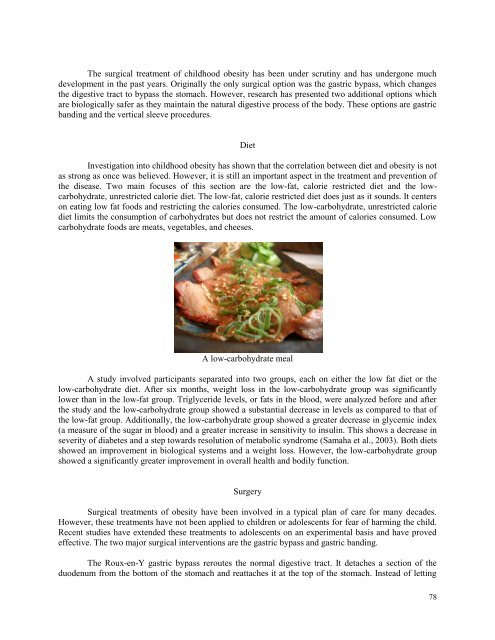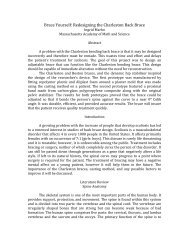Got Food? - the Scientia Review
Got Food? - the Scientia Review
Got Food? - the Scientia Review
Create successful ePaper yourself
Turn your PDF publications into a flip-book with our unique Google optimized e-Paper software.
The surgical treatment of childhood obesity has been under scrutiny and has undergone much<br />
development in <strong>the</strong> past years. Originally <strong>the</strong> only surgical option was <strong>the</strong> gastric bypass, which changes<br />
<strong>the</strong> digestive tract to bypass <strong>the</strong> stomach. However, research has presented two additional options which<br />
are biologically safer as <strong>the</strong>y maintain <strong>the</strong> natural digestive process of <strong>the</strong> body. These options are gastric<br />
banding and <strong>the</strong> vertical sleeve procedures.<br />
Diet<br />
Investigation into childhood obesity has shown that <strong>the</strong> correlation between diet and obesity is not<br />
as strong as once was believed. However, it is still an important aspect in <strong>the</strong> treatment and prevention of<br />
<strong>the</strong> disease. Two main focuses of this section are <strong>the</strong> low-fat, calorie restricted diet and <strong>the</strong> lowcarbohydrate,<br />
unrestricted calorie diet. The low-fat, calorie restricted diet does just as it sounds. It centers<br />
on eating low fat foods and restricting <strong>the</strong> calories consumed. The low-carbohydrate, unrestricted calorie<br />
diet limits <strong>the</strong> consumption of carbohydrates but does not restrict <strong>the</strong> amount of calories consumed. Low<br />
carbohydrate foods are meats, vegetables, and cheeses.<br />
A low-carbohydrate meal<br />
A study involved participants separated into two groups, each on ei<strong>the</strong>r <strong>the</strong> low fat diet or <strong>the</strong><br />
low-carbohydrate diet. After six months, weight loss in <strong>the</strong> low-carbohydrate group was significantly<br />
lower than in <strong>the</strong> low-fat group. Triglyceride levels, or fats in <strong>the</strong> blood, were analyzed before and after<br />
<strong>the</strong> study and <strong>the</strong> low-carbohydrate group showed a substantial decrease in levels as compared to that of<br />
<strong>the</strong> low-fat group. Additionally, <strong>the</strong> low-carbohydrate group showed a greater decrease in glycemic index<br />
(a measure of <strong>the</strong> sugar in blood) and a greater increase in sensitivity to insulin. This shows a decrease in<br />
severity of diabetes and a step towards resolution of metabolic syndrome (Samaha et al., 2003). Both diets<br />
showed an improvement in biological systems and a weight loss. However, <strong>the</strong> low-carbohydrate group<br />
showed a significantly greater improvement in overall health and bodily function.<br />
Surgery<br />
Surgical treatments of obesity have been involved in a typical plan of care for many decades.<br />
However, <strong>the</strong>se treatments have not been applied to children or adolescents for fear of harming <strong>the</strong> child.<br />
Recent studies have extended <strong>the</strong>se treatments to adolescents on an experimental basis and have proved<br />
effective. The two major surgical interventions are <strong>the</strong> gastric bypass and gastric banding.<br />
The Roux-en-Y gastric bypass reroutes <strong>the</strong> normal digestive tract. It detaches a section of <strong>the</strong><br />
duodenum from <strong>the</strong> bottom of <strong>the</strong> stomach and reattaches it at <strong>the</strong> top of <strong>the</strong> stomach. Instead of letting<br />
78
















